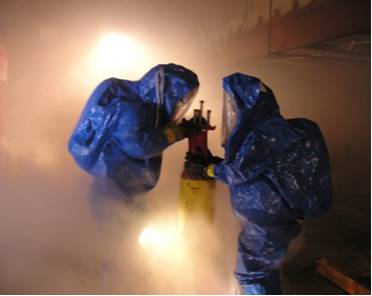
Incident Report Subject: Ammonia Gas can deliver fire-fighters shrink wrapped! Date of Email report: Sun 08/01/2012 Report Detail:
Not a year goes by where I am teaching a HAZMAT or PSM course at an ammonia facility where I am challenged on the fact that NH3 is explosive/flammable. I stress that it takes 160,000 ppm of the gas for it to burn, but it WILL BURN when it reaches this level - all that is needed is an ignition source! Of course the only way anyone could be in 160,000 ppm of Ammonia gas is if they are wearing a LEVEL A suit. And this is the problem... Too often, responders get a blind eye while in these suits, as the vast majority of chemicals responded to in this type of suit are toxic, not flammable. Sort of like fire-fighters in their turn out gear, HAZMAT responders feel they are invincible in their LEVEL A's. I KNOW I HAVE BEEN IN THESE SHOES ALL TOO OFTEN! Last year I posted an article about the Borden's Ammonia Explosion in Houston, TX in December 1983. Well less than a year later (September 1984) in Shreveport, LA a fire-fighter was killed in another ammonia gas explosion. This FF and his partner were both donned in Level A (fully encapsulating suits) when the ammonia gas ignited. One FF died 36 hours later from his burns and his partner survived with 3rd degree burns over 50% of his body. Their suits ignited and melted to them as they were trying to get out of them!!! Below are some critical points to this incident, taken from USFA and NFPA investigation report. Emergency Responders and ammonia operators SHOULD TAKE HEED to these facts as they are presented to us from VERY RELIABLE sources: On Monday, 9/17/1984, at approximately 4:00 p.m., an explosion occurred in a cold storage warehouse building. The explosion occurred while two members of the Shreveport FD HAZMAT Team were attempting to isolate an anhydrous ammonia leak in a section of the building refrigeration system. Employees had earlier detected the leak and workers had begun repairs earlier in the day, but were unable to complete the repair due to the effects of the ammonia. The force of the explosion raised the building's roof assembly in the immediate area of the leak approximately one foot and severely damaged interior wall assemblies. The initial explosion also resulted in a severe fire from the ignition of ordinary combustibles in the adjacent areas of the building. The two FF's within the room of origin were severely burned when their Level A suits became ignited. One FF died within 36 hours of the explosion; the other FF was admitted to a hospital in critical condition. Based on the investigation, the following are considered to be major contributing factors to the loss of life in this incident:
Other IMPORTANT facts from this incident:
Click Here (pdf) to read the entire USFA/NFPA Report.
Additional Documentation:
|

